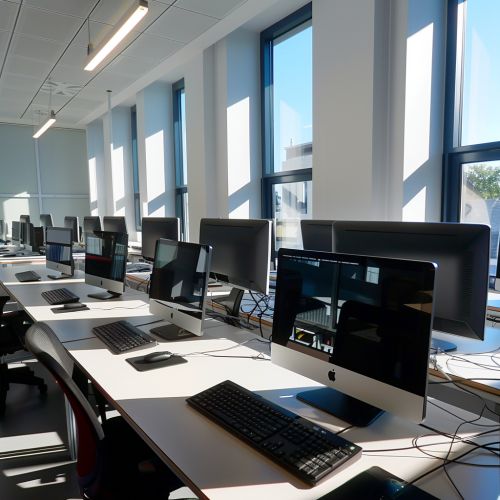Computers
Introduction
A computer is an electronic device that manipulates information or data, capable of performing a wide range of tasks such as calculations, data processing, and automated reasoning. Computers are integral to modern society, impacting various fields including science, engineering, healthcare, education, and entertainment. This article delves into the intricate details of computers, exploring their history, architecture, types, and applications.
History of Computers
The history of computers dates back to ancient times with the invention of the abacus, a simple calculating tool. However, the modern concept of computers began in the 19th century with Charles Babbage's design of the Analytical Engine, a mechanical general-purpose computer. The evolution of computers can be divided into several generations:
First Generation (1940-1956)
The first generation of computers used vacuum tubes for circuitry and magnetic drums for memory. These machines were enormous, consuming vast amounts of electricity and generating significant heat. Notable examples include the ENIAC and the UNIVAC I.
Second Generation (1956-1963)
The second generation saw the replacement of vacuum tubes with transistors, which were smaller, more energy-efficient, and more reliable. Computers like the IBM 7090 and the CDC 1604 emerged during this period.
Third Generation (1964-1971)
The third generation introduced integrated circuits, which allowed for the miniaturization of components and increased computational power. This era saw the development of the IBM System/360 and the PDP-8.
Fourth Generation (1971-Present)
The fourth generation is characterized by the use of microprocessors, which integrate the functions of a computer's central processing unit (CPU) onto a single chip. This period also saw the rise of personal computers (PCs) such as the Apple II and the IBM PC.
Fifth Generation (Present and Beyond)
The fifth generation focuses on artificial intelligence (AI) and advanced computing technologies. Innovations include quantum computing, neural networks, and machine learning algorithms.
Computer Architecture
Computer architecture refers to the design and organization of a computer's core components. The primary components include the central processing unit (CPU), memory, input/output (I/O) devices, and storage.
Central Processing Unit (CPU)
The CPU is the brain of the computer, responsible for executing instructions and performing calculations. It consists of the arithmetic logic unit (ALU), which performs arithmetic and logical operations, and the control unit (CU), which directs the operation of the processor.
Memory
Memory is used to store data and instructions temporarily or permanently. There are two main types of memory: volatile memory, such as random access memory (RAM), which loses data when power is turned off, and non-volatile memory, such as read-only memory (ROM) and flash memory, which retains data without power.
Input/Output (I/O) Devices
I/O devices allow a computer to interact with the external environment. Examples include keyboards, mice, monitors, and printers. These devices facilitate user input and display output.
Storage
Storage devices are used to save data permanently. Common storage devices include hard disk drives (HDDs), solid-state drives (SSDs), and optical discs like CDs and DVDs.


Types of Computers
Computers can be classified based on their size, functionality, and processing power. The main types include:
Supercomputers
Supercomputers are the most powerful computers, capable of performing trillions of calculations per second. They are used for complex scientific simulations, weather forecasting, and cryptographic analysis. Examples include the Cray-1 and the IBM Summit.
Mainframe Computers
Mainframe computers are large, powerful systems used by organizations for bulk data processing, transaction processing, and critical applications. They are known for their reliability and scalability. Notable examples include the IBM zSeries and the Fujitsu GS21.
Minicomputers
Minicomputers, also known as mid-range computers, are smaller than mainframes but still offer substantial processing power. They are used in manufacturing, research, and business applications. Examples include the DEC PDP-11 and the HP 3000.
Personal Computers (PCs)
Personal computers are designed for individual use. They come in various forms, including desktops, laptops, and tablets. PCs are used for a wide range of tasks, from word processing to gaming. Examples include the Apple MacBook and the Dell XPS.
Embedded Systems
Embedded systems are specialized computers integrated into other devices to perform specific functions. They are found in appliances, automobiles, medical devices, and industrial machines. Examples include microcontrollers and system-on-chip (SoC) devices.
Software
Software refers to the programs and operating systems that run on computers, enabling them to perform specific tasks. There are two main types of software: system software and application software.
System Software
System software includes the operating system (OS) and utility programs that manage computer hardware and provide a platform for running application software. Examples of operating systems include Microsoft Windows, macOS, and Linux.
Application Software
Application software consists of programs designed to perform specific tasks for users. Examples include word processors, spreadsheets, web browsers, and graphic design software. Popular applications include Microsoft Office, Adobe Photoshop, and Google Chrome.
Networking and the Internet
Computers are often interconnected through networks, enabling communication and data exchange. The most prominent network is the Internet, a global system of interconnected computer networks.
Local Area Networks (LANs)
LANs connect computers within a limited area, such as a home, office, or campus. They enable resource sharing, such as printers and files, and facilitate communication among connected devices.
Wide Area Networks (WANs)
WANs cover larger geographic areas, connecting multiple LANs. The Internet is the largest WAN, linking millions of private, public, academic, and government networks.
Internet Protocol (IP)
The Internet relies on the Internet Protocol (IP) for addressing and routing data packets. The current version, IPv6, provides a vast address space to accommodate the growing number of connected devices.
Computer Security
Computer security involves protecting computer systems and data from unauthorized access, theft, and damage. Key aspects of computer security include:
Cybersecurity
Cybersecurity focuses on protecting networks, systems, and data from cyberattacks. It encompasses measures such as firewalls, encryption, and intrusion detection systems (IDS).
Data Privacy
Data privacy involves safeguarding personal and sensitive information from unauthorized access and ensuring compliance with regulations such as the General Data Protection Regulation (GDPR).
Malware
Malware refers to malicious software designed to harm or exploit computer systems. Common types of malware include viruses, worms, trojans, and ransomware.
Future Trends
The future of computers is shaped by emerging technologies and innovations. Key trends include:
Quantum Computing
Quantum computing leverages the principles of quantum mechanics to perform computations at unprecedented speeds. Quantum computers have the potential to revolutionize fields such as cryptography, material science, and artificial intelligence.
Artificial Intelligence (AI)
AI involves the development of algorithms and systems that can perform tasks requiring human intelligence, such as natural language processing, image recognition, and autonomous driving.
Internet of Things (IoT)
The IoT refers to the network of interconnected devices that communicate and share data. IoT applications range from smart homes and wearable technology to industrial automation and smart cities.
